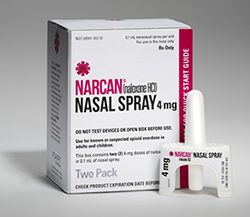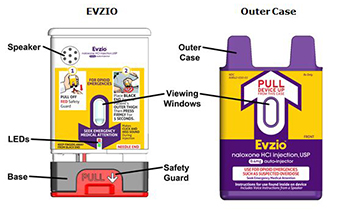Naloxone

Naloxone is a prescription medication that can temporarily reverse opioid overdose and can save lives. Naloxone is an opioid antagonist that reverses the depression of the central nervous and respiratory systems after an overdose of prescription opioids or heroin. This medication can quickly be administered by several easy to use devices. Family members, caregivers, and emergency responders should be trained to administer naloxone to populations at risk for opioid overdose. Below is an overview of the available formulations:
Intranasal Naloxone: Narcan® Nasal Spray 4mg
This naloxone device is a prepackaged, ready-to-use, plastic unit that is given up the nose. The dose can be repeated every 2-3 minutes until initial response.
- How to Use the VA Intranasal Naloxone Kit Training Video
- Narcan® Quick Start Guide [PDF - 677 KB]

Naloxone Auto-Injector
Evzio® is a ready-to-use auto-injector that delivers the naloxone dose intramuscularly. For children under the age of 1 year the Evzio® should be administered subcutaneously. Key features of the device include voice instructions, ability to be administered through clothing, and automatic needle retraction following administration.
How to Use the VA Auto-Injector Naloxone Kit Training Video
Early access to the opioid reversal agent naloxone through community-based models has demonstrated positive outcomes during its use in the last decade. Patients at risk for overdose and their loved ones can be educated on opioid overdose symptoms and administration of naloxone in the community setting. Prescribers and pharmacists can be trained to identify patients at high risk for overdose. In some states, pharmacists can independently prescribe naloxone or can enter into collaborative practice agreements with prescribers to increase access to this life-saving medication. Co-prescribing has benefits for both chronic pain patients as well as patients with opioid use disorders.
Consider co-prescribing naloxone in these situations:
- Recently rotated to a new opioid
- Prescribed morphine equivalent daily (MED) dose of 50mg or more
- On long-acting opioids particularly if in conjunction with short-acting opioids
- Poly-opioid use
- Prescribed opioids greater than 30 days
- Over the age of 65 years
- Households with people at risk of overdose such as children or someone with a substance abuse disorder
- Patients who have difficulty accessing emergency medical services (distance, remoteness, lack of transportation, homelessness, and/or without phone services)
- Recent mandated substance use treatment, incarceration, or period of abstinence with history of drug abuse
- Concurrent prescription or over-the-counter medications
- Benzodiazepines
- Antipsychotics
- Antiepileptics
- Muscle relaxers
- Hypnotics
- Antihistamines
Training Videos
Two IHS Naloxone training videos on opioid reversal and law enforcement are available.
Resources
- IHS Co-Prescribing AdobeConnect presentation
- CDC Guidelines for Prescribing Opioids for Chronic Pain
- SAMSHA Overdose Toolkit [PDF - 467 KB]
- Prescriptive Authority for Pharmacists [PDF - 77 KB]
- Patient Consent Form [PDF - 36 KB]
- Reporting Form to Primacy Care Providers [PDF - 271 KB]
- Prescription Opioid Overdose Prevention in Clinical Settings: New Mexico Department of Health Naloxone Co-prescription Pilot Project [PDF - 692 KB]
- Project Lazarus - Prescribers


